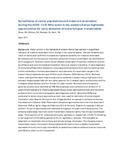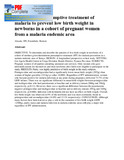| dc.contributor.author | Olanga, Evelyn A | |
| dc.contributor.author | Okombo, Lawrence | |
| dc.contributor.author | Irungu, Lucy W | |
| dc.contributor.author | Mukabana, Wolfgang R | |
| dc.date.accessioned | 2015-04-27T06:59:52Z | |
| dc.date.available | 2015-04-27T06:59:52Z | |
| dc.date.issued | 2015 | |
| dc.identifier.citation | Olanga,Evelyn A., Okombo, Lawrence ., Irungu, Lucy W., Mukabana,Wolfgang R (2015).Parasites and vectors of malaria on Rusinga Island, Western Kenya | en_US |
| dc.identifier.uri | http://www.parasitesandvectors.com/content/pdf/s13071-015-0860-z.pdf | |
| dc.identifier.uri | http://hdl.handle.net/11295/82035 | |
| dc.description.abstract | Background There is a dearth of information on malaria endemicity in the islands of Lake Victoria in western Kenya. In this study malaria prevalence and Plasmodium sporozoite rates on Rusinga Island were investigated. The contribution of different Anopheles species to indoor and outdoor transmission of malaria was also determined. Methods Active case detection through microscopy was used to diagnose malaria in a 10% random sample of the human population on Rusinga Island and a longitudinal entomological survey conducted in Gunda village in 2012. Nocturnally active host-seeking mosquitoes were captured indoors and outdoors using odour-baited traps. Anopheles species were tested for the presence of Plasmodium parasites using an enzyme linked immunosorbent assay. All data were analyzed using generalized linear models. Results Single infections of Plasmodium falciparum (88.1%), P. malariae (3.96%) and P. ovale (0.79%) as well as multiple infections (7.14%) of these parasites were found on Rusinga Island. The overall malaria prevalence was 10.9%. The risk of contracting malaria was higher among dwellers of Rusinga West than Rusinga East locations (Odds Ratio [OR] = 1.5, 95% Confidence Interval [CI] 1.14 – 1.97, P = 0.003). Parasite positivity was significantly associated with individuals who did not use malaria protective measures (OR = 2.65, 95% CI 1.76 – 3.91, p < 0.001). A total of 1,684 mosquitoes, including 74 anophelines, were captured. Unlike Culex species, more of which were collected indoors than outdoors (P < 0.001), the females of An. gambiae s.l. (P = 0.477), An. funestus s.l. (P = 0.153) and Mansonia species captured indoors versus outdoors were not different. The 46 An. gambiae s.l. collected were mainly An. arabiensis (92.3%). Of the 62 malaria mosquitoes tested, 4, including 2 indoor and 2 outdoor-collected individuals had Plasmodium. Conclusion The rather significant and unexpected contribution of P. malariae and P. ovale to the overall malaria prevalence on Rusinga Island underscores the epidemiological importance of these species in the big push towards eliminating malaria. Although current entomological interventions mainly target indoor environments, additional strategies should be considered to prevent outdoor transmission of malaria. | en_US |
| dc.language.iso | en | en_US |
| dc.publisher | university of nairobi | en_US |
| dc.subject | Malaria, Malaria prevalence, Plasmodium falciparum, P. malariae, P. ovale, Malaria, Anopheles, Culex, Mansonia, Indoor transmission, Outdoor transmission, Capture fishing, Rusinga Island, Kenya | en_US |
| dc.title | Parasites and vectors of malaria on Rusinga Island, Western Kenya | en_US |
| dc.type | Article | en_US |
| dc.type.material | en_US | en_US |




